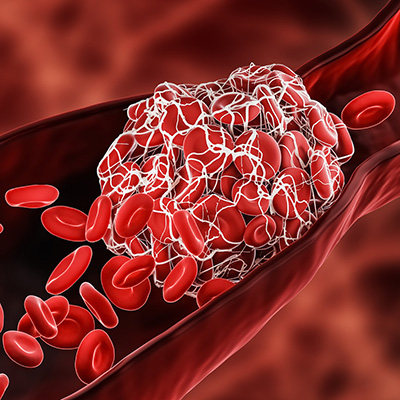Vitality eNews Sign Up
Receive the Summa Health eNewsletter for the latest health tips, advice and updates.
Blood Clots What You Need to Know and How to Help Prevent Them
Posted August 22, 2022 by Roger Chaffee, M.D.

When you cut yourself and injure a blood vessel, blood clotting is an important process that seals your wound and prevents excessive bleeding. Once your injury is healed, the body naturally dissolves the blood clot.
Blood clots can also form inside the blood vessels without an injury and do not dissolve naturally. This can become life-threatening and cause long-term effects, such as breathing problems or chronic swelling.
Any blood clot that forms in your veins or arteries can be serious, but the most common and dangerous type of blood clot is a deep vein thrombosis (DVT). They are clots of red blood cells found in a deep vein, normally in the arm or leg. Sometimes, a clot can break off and travel to the lungs, called a pulmonary embolism, and can cause death.
More than 100,000 people die from DVT in the United States every year, according to the American Society of Hematology. That’s more than the number of deaths caused by AIDS, car accidents and breast cancer combined. Despite the prevalence, many people are largely unaware of the symptoms and risk factors of DVT.
Learn more about blood clot symptoms, risk factors, prevention and treatment so you can be proactive in your health, spot the signs and hopefully even prevent this potentially life-threatening condition.
Blood clot symptoms
Symptoms of a blood clot depend on its location. Blood clots in the brain can cause strokes and those formed in heart arteries can cause heart attacks. Blood clots also can form in the abdominal blood vessels and cause pain, nausea and vomiting.
With DVT, some people don’t experience any symptoms at all, while others may experience symptoms in the affected area, normally the arm or leg:
- Swelling
- Pain or cramping
- Redness, tenderness or warmth
If you’re experiencing a pulmonary embolism, symptoms can include:
- Shortness of breath
- Pain in the rib cage
- Faster or irregular heartbeat
- Coughing up blood
If you suspect you have a blood clot, seek medical attention right away.
Blood clot risk factors
You’re at a higher risk for blood clots if you:
- Had a prior DVT
- Are over the age of 65
- Are undergoing major surgery
- Are obese
- Have a family history of blood clots
- Experience prolonged immobility, such as bed rest or long car/plane trips
- Have cancer and/or undergoing chemotherapy
- Have blood diseases, such as high blood pressure or high cholesterol
- Had a recent stroke
- Take certain medications, such as birth control pills
Blood clot diagnosis and treatment
If a blood clot is suspected, your healthcare provider may order a blood test to detect a compound released from the clot. Additionally, an ultrasound or CT scan may be performed on the affected area.
Blood clots are most commonly treated with prescription blood thinners. If the clot is very large or life-threatening, you will be hospitalized to receive clot-dissolving medication or get it removed surgically.
Blood thinners can help blood clots from forming or getting bigger and allows your body to break it down naturally. They also can protect you against heart attacks and strokes.
There are two types of blood thinners: anticoagulants and antiplatelets. Anticoagulants are often prescribed to help dissolve existing blood clots and keep new ones from forming. Antiplatelets are typically prescribed if you’re at risk for future blood clots.
Some people only need these medications for a few months, however if you have long-term health problems, you may need to take them long-term.
Blood thinners do come with risks for those who take them. They are decided to help prevent blood clotting, so they can cause you to bleed more than usual when you cut or bruise yourself. If you’re on these medications you should take extra precaution when engaging in activities that could cause injury, especially head trauma. Even if you experience a substantial hit and the skin doesn’t tear, you could bleed internally.
Preventing blood clots
The good news is there are several ways to help prevent blood clots from forming, especially when controlling your risk factors. Staying active and avoiding sedentary activities for long periods of time, maintaining a healthy diet and weight, and not using tobacco products are important for reducing your risk.
If you’re at risk due to genetics or family history, talk to your healthcare provider. Blood thinners can be prescribed to help prevent blood clots. Additionally, compression stockings provide pressure on the legs and can help prevent their formation, as well.
Once you get a blood clot, you’re at a higher risk of getting another one. Talking to your doctor and taking the necessary precautions are important steps in reducing your risk.
